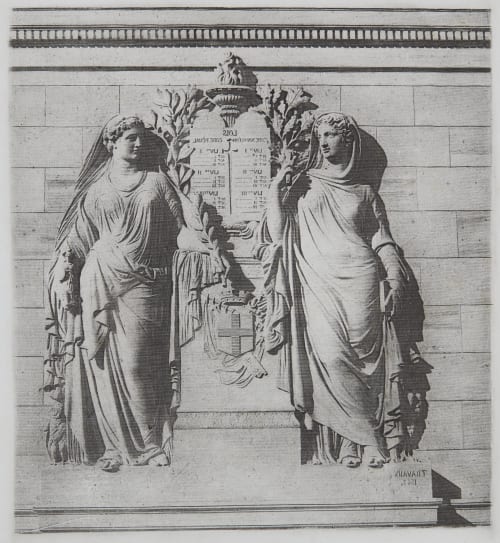
Title
UntitledArtist
Disderi (French, 1819-1889)Date
1863Process
Halftone (Girard)Atelier
GirardImage Size
12.5 x 11.5 cmSheet Size
24.3 x 21.2 cm
Finally, engraved photography is suitable for any application to industry or the arts. It can scale down maps and plans used by the army, can copy and multiply the riches found in our art academies, machines, tools, monuments, vessels, etc. It can if needed take a painting by one of our leading artists and within a few days disseminate an engraving of it throughout the world. Andre Disderi [1]
Alexis Barthelemy Girard is virtually unknown in the history of photography and photomechanical reproduction, but is important because he and photographer Andre Disdéri were the first to attempt a commercial application of an intaglio halftone process in 1863. Disderi’s involvement was a direct outgrowth of his belief in publications of art, historical artifacts, natural history, and everyday goods to educate and benefit the general populace (a form of what later would be called a "museum without walls").
Girard appears with a radical innovation in 1863, the commercialized printing of art and photography by a ruled screen halftone method in intaglio. Along with one of the most successful photographic entrepreneurs of the age, Andre Disderi, Girard attempted to market prints to a buying public. Unfortunately Girard and his method failed to enter the historiographical record most likely because he worked for such a short time and was generally overlooked by the photographic societies and printing journals of his day. Viable commercial breakthrough was finally achieved by 1881 when a number of inventors in both Europe and the United States finally developed workable relief line screen halftone systems.
Examples of the Girard process are rare. A group of three prints by Girard had been deposited with the Societe française de photographie in 1921. They reside in the collection as a gift from Monsieur Monpillard. The Bibliothèque nationale de France has an album containing 32 examples. All of the prints have attached explanatory labels in a calligraphic hand. Most of the prints are from art while only nine are after photographs from life: portraits, stands in the Exposition Universelle of 1855, a bas relief sculpture (our print) and finally an regimental banner for Napoleon’s imperial guard. The plates vary in size with the largest being 31.5 x 24.5 cm. Practically all the prints bear the phrase "sans retouche" indicating that no hand correction had been done on the plate. The Clark Art Institute of Williamstown, MA recently acquired a copy of the same album. All of the prints created from Girard’s plates were executed by Alfred Salmon, an intaglio printer who had learned the trade with Chardon aine. Salmon had just opened his own printing shop in 1863 at Rue de la Vieille Estrapade 15 in Paris, where he would operate until 1880.
Thus this print an extremely rare and important link in the evolution of photomechanical reproduction. [2] [3]
References
[1] Introduction written by Andre Disderi in 1863 from a unique album of prints held at the BNF. See Hanson P. 50
[2] David A. Hanson and Steven F. Joseph, “’Heralding A New Era’: B. A. Girard’s Method of Photomechanical Halftone in France, 1863” in Printing History, New Series Number 29–30 (Combined Issue 2021)
[3] Marbot, Bernard. After Daguerre: Masterworks of French Photography (1848-1900) from the Bibliothèque Nationale. New York: Metropolitan Museum of Art, in association with Berger-Levrault, Paris, 1980.
